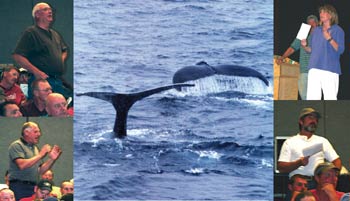MLA Makes Its Case
by Laurie Schreiber
|
The Maine Lobstermen’s Association worked right up to the Sept. 17 comment deadline to convince the National Marine Fisheries Service to provide a broader exemption area to its sinking groundline requirement. And the Maine Department of Marine Resources has been working to convince NMFS to change the implementation date of the requirement from Oct. 1, 2008 to October 2010. NMFS is scheduled to issue its final whale rule on Oct. 1.
“If there’s a door to knock on, we’re knocking on it,” MLA executive director Patrice McCarron told an Aug. 30 gathering of fishermen in Ellsworth, where about 120 people turned out to discuss potential action to address the rule. MLA also held meetings in Saco and Rockland. McCarron and MLA president David Cousens, were also in Washington, D.C., to discuss the rule with Maine’s delegation and the Office of Management and Budget. They met with the Small Business Administration and SBA’s Regional Ombudsman in Portland to file a complaint about unfair treatment to the industry. And they met with Governor John Baldacci and with Portland-area editorial boards to address negative publicity about the lobster fishing industry.
The MLA is asking NMFS to move the exemption line further offshore, to the 50-fathom curve. Nearly all right whale sightings since 1972 have been outside the 50-fathom curve. “Our only bet is to prove, scientifically, that the whales aren’t here,” said Cousens. “We all know the whales aren’t here. But we’ve got to prove it.”
The industry sees good reason to draw the exemption boundary further offshore, McCarron said. The MLA, she said, is working with a GIS specialist to re-examine whale sightings and other data to support this request. It’s up to the industry to prove that whales are not inside the 50-fathom curve, said Jon Carter of Bar Harbor..
continue
|

“We are going to lose a bunch of gear.” —Darrell Beal, Beals Island (upper left); “We’ve got to raise money to fight this thing.” —Dwight Carver, Newfield (lower left); “A full blown lawsuit against NMFS could amount to $500,000 or more.” —Patrice McCarron, MLA, (upper right); “Even $500,000 isn’t going to be enough, NMFS can chew it up.” —Cappy Sargent, Milbridge, (lower right) Laurie Schreiber photos, center photo NOAA |
|
|
|
|
Glenn Holland And The Red Baron
by Mike Crowe
|
The Red Baron has earned its position as an icon in the history of lobster boat racing in Maine. The roots of its success are just what any fan of lobster boat racing would want them to be. Its success did not come out of an MIT engineering lab where a corporation threw bushels of money at it until it did what they wanted. The Red Baron’s roots are in the tradition of Maine boat building, its designer and builder Glenn Holland, and the network of boat builders and boats Holland grew up among.
The hull design that enabled the Red Baron to be the winning boat it has been evolved out of Glenn Holland’s nearly lifelong interest in boats and speed. Holland built a lot of boats before working out the hull that produced the Red Baron.
Born in Castine, Holland hung around the Billings boatyard in Stonington, where his family had moved. Ever since those early years he wanted to build boats. His father was a lobsterman and as a teen Glenn built models. In high school his papers would be turned in with boats sketched on them.
continue
|

Glenn Holland with his grandson at the Searsport races in 2007. His grandson holds the check he had just won in the skiff race. Overjoyed the grandson declared, “I could make a living doing this!” Brenda Tredwell photo |
|
|

